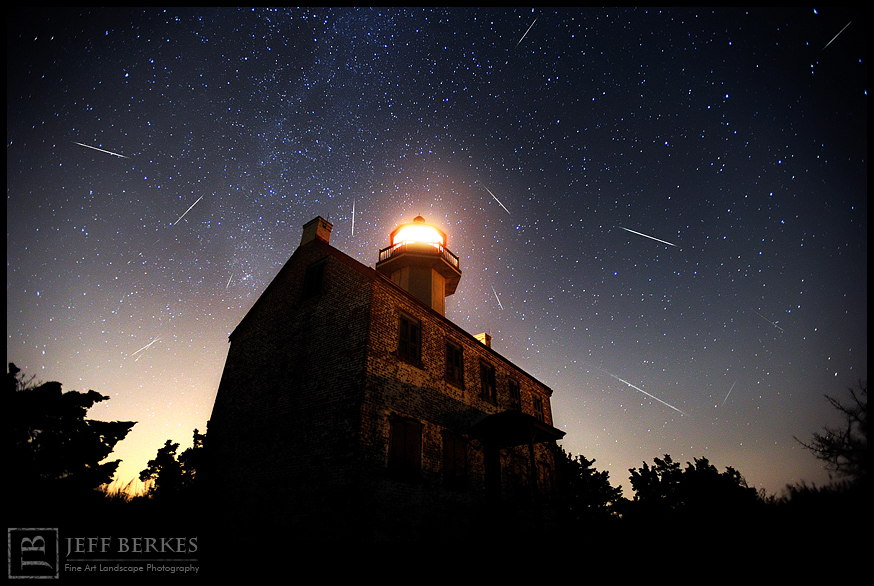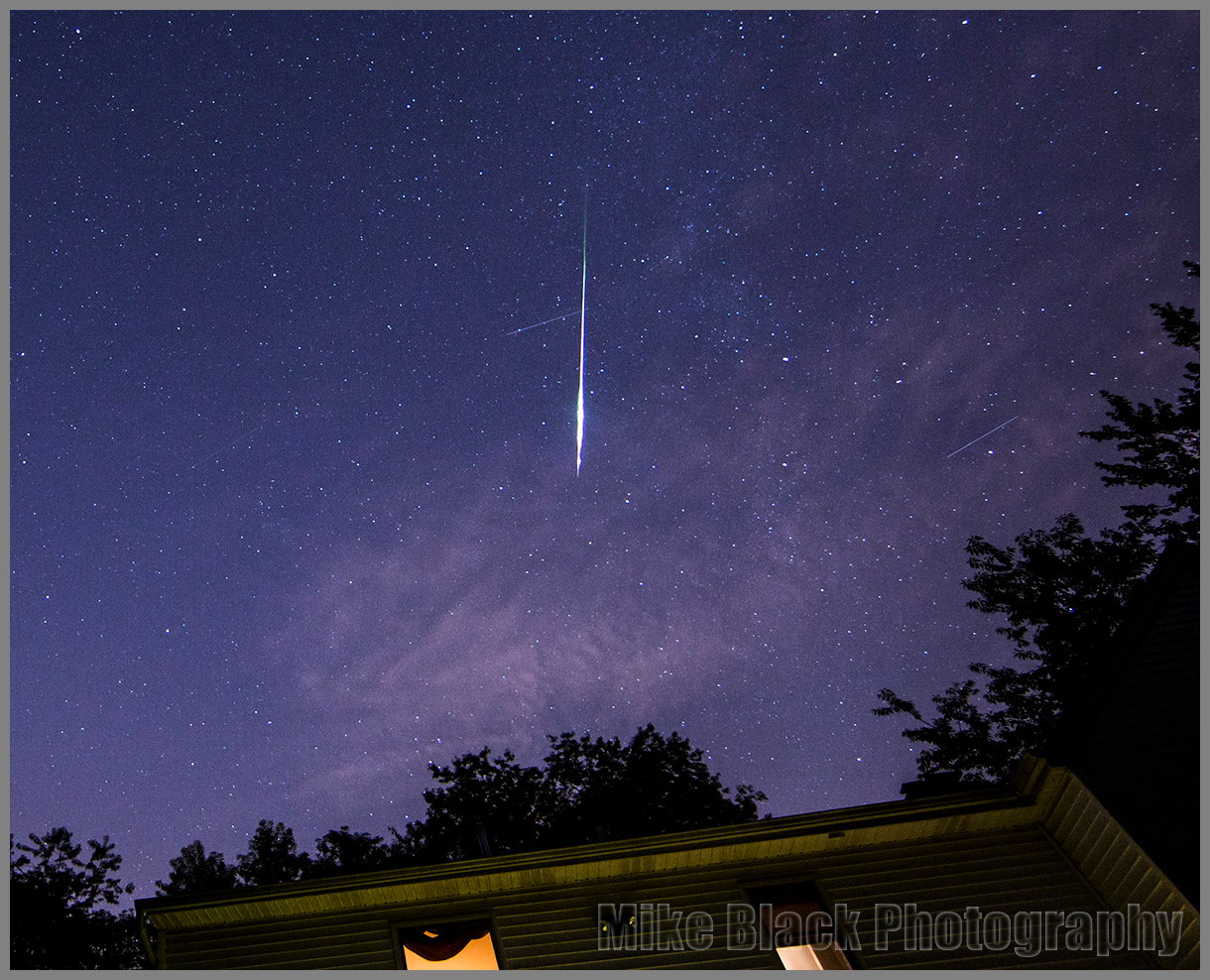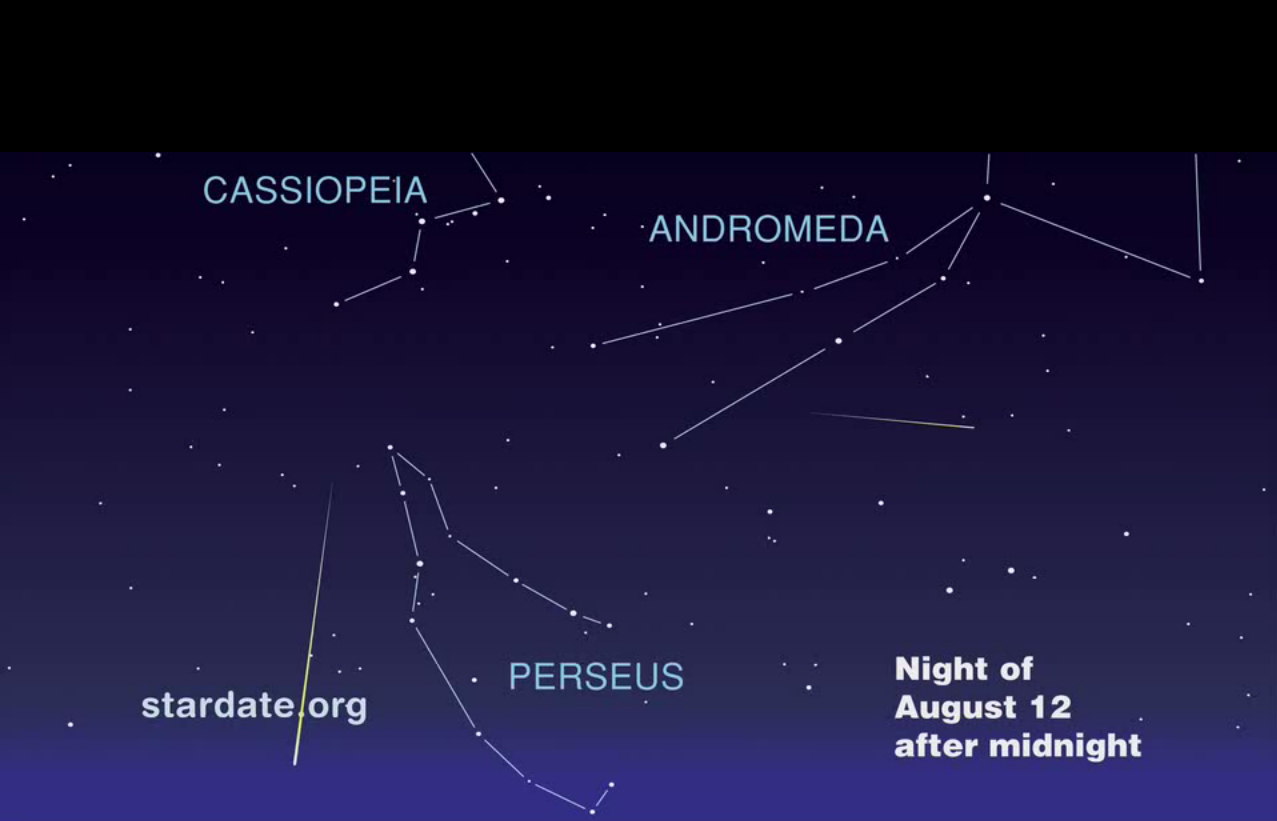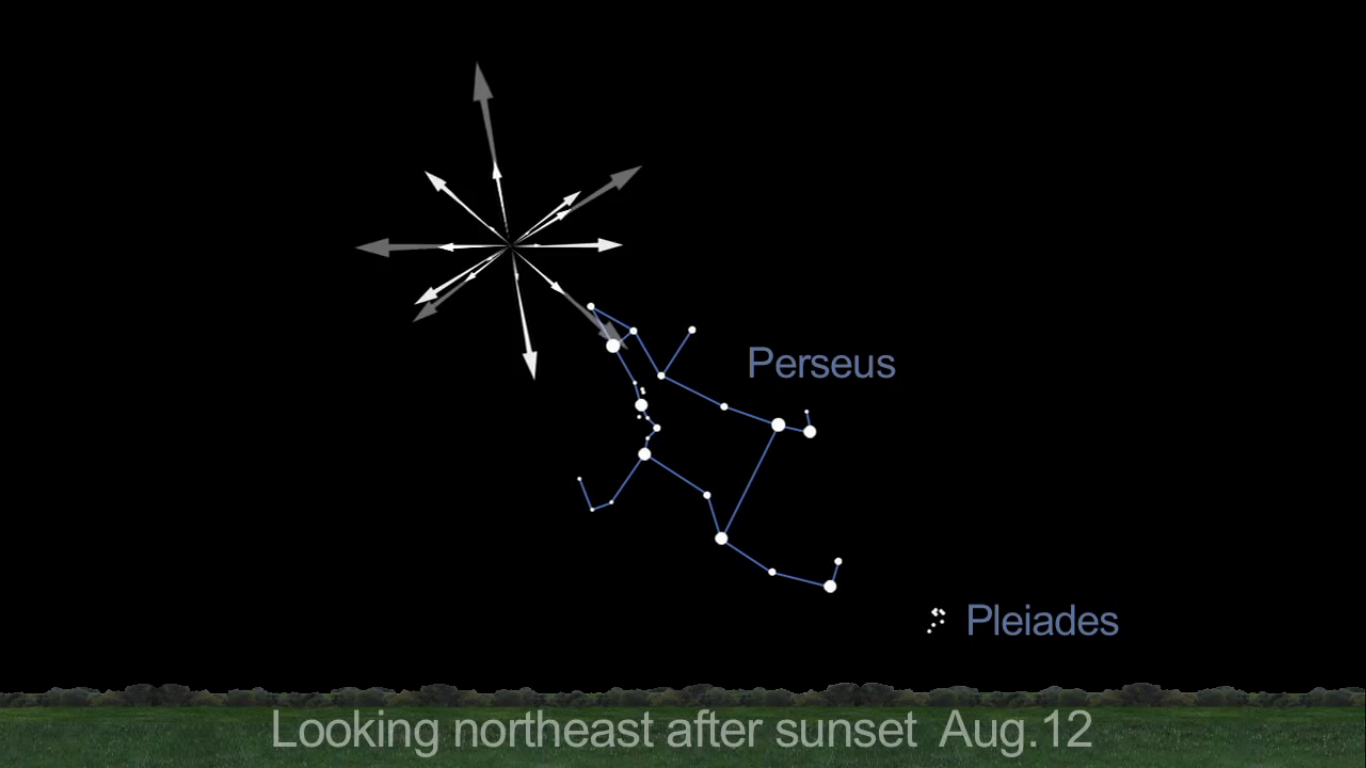
UPDATE: See the latest 2013 Perseid meteor shower photos and details for an Aug. 12 Perseids webcast here: Amazing Perseid Meteor Shower Photos: Celestial Fireworks Wow Stargazers
Every August, just when many people go vacationing in the country where skies are dark, the best-known meteor shower, makes its appearance.
This year, the Perseid meteor shower is expected to reach its peak overnight on Monday (Aug. 12), and there are some key tips to keep in mind for your "shooting stars" viewing. You can watch live Perseid meteor shower webcasts on SPACE.com, courtesy of NASA and the Slooh Space Camera.

Peak activity for the Perseids is unfortunately predicted for the daylight hours across North America, so stargazers with clear skies are encouraged to seek out the meteor display during the pre-dawn hours of Monday and again during the early morning hours of Tuesday (Aug. 13). At these times, the absence of bright moonlight can maximize your chances of spotting a meteor. [See 2013 Perseid meteor shower photos by stargazers (Gallery)]
At mid-northern latitudes, moonset on Sunday evening (Aug. 11) occurs at about 10:15 p.m. local time and around 10:50 p.m. the following night. Since dawn doesn't break until around 4:30 a.m. local time that means there will be between five-and a-half to six hours of dark, moonless skies for the two best viewing nights for the Perseids.
Take full advantage of this year's favorable lunar circumstances. Next year, a bright waning gibbous moon will flood the after-midnight night sky with its light and seriously hinder the Perseids.
Perseids: the remains of a comet
Get the Space.com Newsletter
Breaking space news, the latest updates on rocket launches, skywatching events and more!
![Learn why famous meteor showers like the Perseids and Leonids occur every year [See the Full Infographic Here].](https://cdn.mos.cms.futurecdn.net/VDWEKQFLr8yuXkTL4YkHqj.jpg)
We know today that the Perseid meteor shower is actually created by the remains of the Comet Swift-Tuttle. Discovered back in 1862, this comet takes approximately 130 years to circle the sun. And in much the same way that the Comet Tempel-Tuttle leaves a trail of debris along its orbit to produce the Leonid meteor shower of November, Comet Swift-Tuttle produces a similar debris trail along its orbit to cause the Perseids display. [Top 10 Perseid Meteor Shower Facts]
Every year during mid-August, the Earth passes near the orbit of Swift-Tuttle and crosses the comet's debris stream. The comet material left behind then ram's into our atmosphere at approximately 37 miles per second (about 133,000 mph/214,000 km/h) to create bright streaks of light in our mid-summer night skies.
Comet Swift-Tuttle made its most recent appearance more than 20 years ago, in December 1992. Its orbit is highly elongated and as such it takes roughly 130 years to make one trip around the sun.
For several years before and after its 1992 return, the Perseids were a far more prolific shower, appearing to produce brief outbursts of as many as several hundred meteors per hour, many of which were dazzlingly bright and spectacular. The most likely reason was that the Perseids parent comet was itself passing through the inner solar system and that the streams of Perseid meteoroids in the comet's vicinity were larger and more thickly clumped together, leading to brighter meteors as well as much-higher-than-normal meteor rates.
But now, with the comet now having retreated nearly 3.2 billion miles (5.1 billion km) back out into space, Perseid activity has returned to normal.
Perseid meteor clumps
A very good meteor shower will produce about one meteor per minute for a given observer under a dark country sky. However, any light pollution from city lights or moonlight considerably reduces the count.
The August Perseids are among the strongest of the readily observed annual meteor showers, and at maximum activity nominally yield 90 or 100 meteors per hour. However, observers with exceptional skies often record even larger numbers.
But while 90 to 100 meteors per hour correspond to at least one meteor per minute, keep in mind that this is only a statistical average. In reality, what usually is seen is what some have called, "the clumping effect." Sometimes you'll see two or even three Perseids streak across the sky in quick succession, all within less than minute. This is usually followed by a lull of several minutes or more, before the sky suddenly bears fruit once again.

When and where to look
Typically during an overnight watch, the Perseids are capable of producing a number of bright, flaring and fragmenting meteors, which leave fine trains in their wake. On the night of shower maximum, the Perseid radiant is not far from the famous "Double Star Cluster" of Perseus.
Low in the northeast during the early evening, it rises higher in the sky until morning twilight ends observing. Shower streakers appearing close to the radiant have foreshortened tracks; those appearing farther away are often brighter, have longer tracks, and move faster across the sky. About five to 10 of the meteors seen in any given hour will not fit this geometric pattern, and may be classified as sporadic or as members of some other (minor) shower.
Perseid meteor shower activity increases sharply in the hours after midnight, so plan your observing times accordingly. We are then looking more nearly face-on into the direction of the Earth’s motion as it orbits the sun, and the radiant is also higher up.

Making a meteor count is as simple as lying in a lawn chair or on the ground and marking on a clipboard whenever a "shooting star" is seen. Watching for the Perseids consists of lying back, gazing up into the stars, and waiting. It is customary to watch the point halfway between the radiant (which will be rising in the northeast sky) and the zenith, though it's all right for your gaze to wander.
Meteor counts should be made on several nights before and after the predicted maximum, so the behavior of the shower during off-peak nights can be determined. Usually, good numbers of meteors should be seen on the preceding and following nights as well. The shower is generally at one-quarter strength one or two nights before and after maximum.
A few Perseids can be seen as much as two weeks before and a week after the peak. The extreme limits, in fact, are said to extend from July 17 to Aug. 24, though an occasional one might be seen almost anytime during the month of August. [Early Perseid Meteor Shower Fireballs Seen by NASA (Video)]

No danger in watching
Many years ago, a phone call came into New York's Hayden Planetarium. The caller sounded concerned after hearing a radio announcement of an upcoming Perseid meteor display and wanted to know if it would be dangerous to stay outdoors on the night of the peak of the shower (perhaps assuming there was a danger of getting hit).
These meteoroids, however, are no bigger than sand grains or pebbles, have the consistency of cigar ash and are consumed many miles above our heads. The caller was passed along to the Planetarium's Chief Astronomer who commented that there are only two dangers from observing the Perseid meteor shower: getting drenched with dew and falling asleep!
August is also the month of "The Tears of St. Lawrence," which has a historic link to the Perseids.
Laurentius, a Christian deacon, is said to have been martyred by the Romans in 258 AD on an iron outdoor stove. It was in the midst of this torture that Laurentius cried out: "I am already roasted on one side and, if thou wouldst have me well cooked, it is time to turn me on the other."
The saint’s death was commemorated on his feast day, Aug. 10. King Phillip II of Spain built his monastery place the "Escorial," on the plan of the holy gridiron. And the abundance of shooting stars seen annually between approximately Aug. 8 and 14 have come to be known as St. Lawrence's "fiery tears."
Whether you plan to make detailed meteor counts or just lie back and watch nature put on a show, there should be plenty to during the predawn hours of Aug. 12 and 13. As one long-time meteor enthusiast once noted: "Meteor observing is relaxing and enjoyable, potentially dramatic and just plain fun!"
Editor's Note: If you snap an amazing picture of the 2013 Perseid meteor shower or any other night sky view that you'd like to share for a possible story or image gallery, send photos, comments and your name and location to managing editor Tariq Malik at spacephotos@space.com.
Joe Rao serves as an instructor and guest lecturer at New York's Hayden Planetarium. He writes about astronomy for Natural History magazine, the Farmer's Almanac and other publications, and he is also an on-camera meteorologist for News 12 Westchester, N.Y. Follow us @Spacedotcom, Facebookand Google+. Original article on SPACE.com.
Join our Space Forums to keep talking space on the latest missions, night sky and more! And if you have a news tip, correction or comment, let us know at: community@space.com.

Joe Rao is Space.com's skywatching columnist, as well as a veteran meteorologist and eclipse chaser who also serves as an instructor and guest lecturer at New York's Hayden Planetarium. He writes about astronomy for Natural History magazine, Sky & Telescope and other publications. Joe is an 8-time Emmy-nominated meteorologist who served the Putnam Valley region of New York for over 21 years. You can find him on Twitter and YouTube tracking lunar and solar eclipses, meteor showers and more. To find out Joe's latest project, visit him on Twitter.









